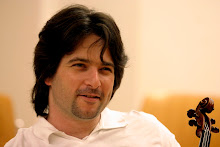In practicing basic technique – to concentrate purely on one aspect of technical problem without paying any attention to anything else is a grave mistake. While working on intonation, for example, you should always keep your eyes on the right arm as well and focus your tone.
In practicing pieces – practicing shifts without considering the speed and direction of the shift and whether you will use vibrato or not.
In practicing pieces – learning initially “only the notes” without musical agenda is one of the most common mistakes by students. Since the music agenda dictates speed, loudness, articulation, phrasing, timing, fingerings, tone production, use of vibrato and bowings, to say the least, not considering musicality from the very first stages makes the entire process of practicing a waste of time.
In practicing pieces – not bringing immediately (on first practice session) every segment that is played to performance level. Playing a piece or a segment of a piece, thinking “it will be good one day, maybe tomorrow, or the day after…” is never going to help you get it right. From the very beginning of learning you should strive to bring yourself to performance level (including learning by heart), and it does not matter whether you are practicing two lines, two measures or a whole fugue.
Not asking “why did it go right?” – We make a point when thing go wrong but seldom stop to think when we make it right. This is a crucial point of practicing since after spending time and effort and having overcome the difficulty, we should ask ourselves the following questions:
What have we done to make this work,
And
Can we guarantee that it will work in performance the first time we play it (hint: if the answer is “no”, do it again).
Not practicing with “performance mentality” – there is a vast difference, both mentally and physically, between playing through a piece after an hour or two of practice while being alone in a room, and stepping on a stage and doing it for the first time in front of a panel of jury. In the first case you feel warmed up and safe, having played the piece several times and it being fresh in your mind and knowing that you can stop at any time. In the second case you have to perform your best under great pressure and play through the piece without stopping to correct yourself or being given a second chance.
Many times I heard students complain “but it worked in the practice room” only to find out that they never tried to play the piece through before the lesson or did not properly learned it by heart. When you get to performance level make sure you put yourself under the same conditions as a real performance. This includes: recording yourself, playing the piece through with only a short warm up, awareness of where you will be playing (big stage, sitting down), the amount of movement space (never walk around) and performing to friends.
In practicing technique – not making the connection between the technical element you are improving and the pieces you are playing. Did you just spent precious time working on your spiccatto? Why not move immediately to the moment in the pieces you need to use it. Worked two hours on correcting your bow arm? Don’t throw it to the wind the second you begin playing the concerto.
Losing the ideal - always be connected to the mental “image”, or “sound”, of what you are trying to achieve. Never let your hands dictate the music and keep measuring what you actually play to what you really want to play.
“I already know that part” – no you don’t… and its younger sibling: “that’s easy” (no it’s not).
Not knowing the piano part/orchestra part of the sonata/concerto – of all the silly mistakes…
Following blindly the fingerings and bowings that are on the page – not every fingering is good for all players and not all bowings have the same musical agenda you might have. Mix it up, try different things, be imaginative, daring and curious about the sound variations you can produce. Come on… live a little.
Not following blindly the fingerings I gave you in our last lesson – yes, I know… (But it makes sense to me).
Subscribe to:
Post Comments (Atom)

1 comment:
From the very beginning of learning you should strive to bring yourself to performance level - love the idea.
I don't think I ever did that (even though years ago I did perform. Well, at the consrvatory in front of students and their parents).
I've been playing for a little more than two years now (a year and 4 monthes - 18 years ago, and back again 10 monthes ago), still making my first steps, so I guess it's supposed to be much easier to correct these mistakes.
The connection bewteen the technical elements and the piece one is playing - one of my serious problems is when changing the bow when it's on the head: when practicing open strings or two notes, I'm doing fine, but when playing scales or a piece I fail. I'll make sure to ask myself: why did it go right? when I get that right.
About the loosing the ideal - I do follow that. I have an ideal for everything! I play. What if when you play, you hear what you want to play and not what you actually play? Does that make any sense?
As for the mistake of following blindly the fingerings and bowings that are on the page - well, I never questioned them.
Thanks a lot for this very contributing post.
Post a Comment